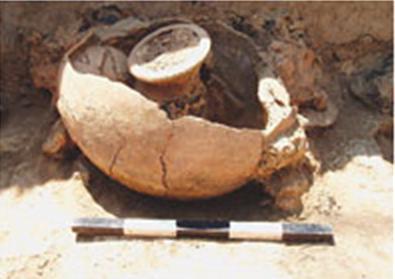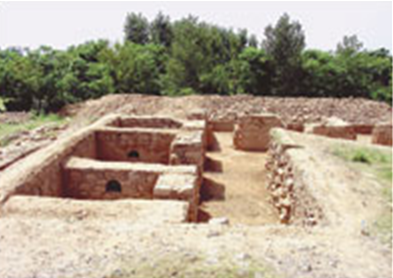Badalpur, near Taxila
| Line 43: | Line 43: | ||
[[File:Badalpur, near Taxila3.png| Badalpur, near Taxila |frame|500px]] | [[File:Badalpur, near Taxila3.png| Badalpur, near Taxila |frame|500px]] | ||
| + | [[File:Badalpur, near Taxila4.png| Badalpur, near Taxila |frame|left|500px]] | ||
The only gold coin of the Kushan period belongs to the rule of Kanishka-I and is essentially of the pedigree of the coins on display at Sri Partap Singh Museum in Srinagar and the British Museum, London. This coin has a Greek inscription "Shaonanoshao Kaneshki Koshano' (The king of kings Kanishka the Kushan) on the obverse and a legend on the reverse. | The only gold coin of the Kushan period belongs to the rule of Kanishka-I and is essentially of the pedigree of the coins on display at Sri Partap Singh Museum in Srinagar and the British Museum, London. This coin has a Greek inscription "Shaonanoshao Kaneshki Koshano' (The king of kings Kanishka the Kushan) on the obverse and a legend on the reverse. | ||
| − | |||
| − | |||
Dr Arif says in his report that the period in which the cells were built and other structures raised is estimated and calculated on the basis of the evidence supplied by coins, inscribed seals and stone masonry of the cells of the monasteries. This type of masonry is found in early diaper which represents around late second century AD. It may, therefore, be concluded that all the structures of Badalpur were constructed around the same time. | Dr Arif says in his report that the period in which the cells were built and other structures raised is estimated and calculated on the basis of the evidence supplied by coins, inscribed seals and stone masonry of the cells of the monasteries. This type of masonry is found in early diaper which represents around late second century AD. It may, therefore, be concluded that all the structures of Badalpur were constructed around the same time. | ||
Revision as of 17:23, 23 October 2013
This is a collection of articles archived for the excellence of their content. Readers will be able to edit existing articles and post new articles directly |
Badalpur, near Taxila
Badalpur — a newfound ancient site
By Mahmood Zaman
Taxila has been the proud cradle of one of the most ancient universities in this part of the world when it was known as Takshasila and where Buddhism flourished since the reign of Ashoka the Great in 272-232 BC. This university imparted learning in art, music, logic, mathematics, medicine, astronomy and many other disciplines. Though the site is now in ruins, the lingering presence of monasteries shows that religious learning was the paramount feature of one of these oldest seats of learning.
The imposing monasteries and cells for monks at Julian, a village north of the main remains of Taxila, show how important was the teaching of religion in those days. Taxila witnessed the rule of several major powers of the time starting from Iranians (600-400 BC) Greeks (326-324 BC), Mauryans (324-185 BC), Indo-Greeks (250-190 BC), Scythians (second century to first century BC), Parthians (first century BC to first century AD), Kushans (first to fifth century AD), White Huns (fifth century AD) and Hindu Shahi (ninth to 10th century AD). During the period, Ashoka the great Buddhist acquired a foothold here and his rule reached its climax during the Kanishka rules in AD 128.
Sir John Marshal, the first director-general of the Archaeological Survey of India, discovered Taxila between 1913 and 1934. He and other archaeologists of eminence, including Sir Alexander Cunningham and V Natesa Aiyar, superintendent of the Frontier Circle of the Archaeological Survey of India, also mentioned an extension of Taxila at Badalpur, located near village Behra in the valley of river Haro, close to district Haripur Hazara in the NWFP. The site, protected as an archaeological mound since 1930, extends to three acres of land some 10 kilometers north-east of the Taxila Museum.
This is the first time that the site at Badalpur was excavated between June and August 2005 by an 11-member team of archaeologists, headed by Dr Mohammad Arif. This team found the site almost congruous to Taxila but different from its structures which are held with mud plaster from the exterior and interior surfaces, a distinguished feature of this site which is absent in Taxila. Another major find is a complex of eight cells for monks with the main entrance still intact on its western front.
A gold coin of the Early Kushan period, five complete copper 'chattars (Umbrellas) of votive stupas, a big iron pan of one meter diameter, a ritual pot in copper, a surgical instrument, copper plates and pendants, a copper bell and a strainer, and iron objects like nails, clamps, hinges, a saw, a pair of tongs, door bosses and stripes with nails were also recovered from the site. Besides, a large number of pottery pieces like storage jars, pots, cups, bowls, a terracotta oil lamp and a heart-shaped schist stone lamp were also found in addition to 188 copper coins and a hoard of 128 seals.
Dr Arif has said in his report, since submitted to the federal government, that the use of lime stone on mud mortar for the construction of the walls around monasteries, which also have verandas in front, is the most startling feature of Badalpur. Sir John Marshal said in his report on Taxila that the remains do not have mud plaster support of walls. But the site at Badalpur tells a different story. He says that the cells (307 cm thick on eastern side, 316 cm thick on the north-south side and 110 cm wide) were used by monks who used to come here from all corners of India to learn Buddhism. Fire hearths in verandas were also found to show that monks used to cook food for them. They were identified with the help of 37 cm thick debris of fire ash of charred timber and charcoal. The masonry of the cells is in diaper and some places are as high as 234 centimeters.
As for the pair of tongs, he says that they may have been in the use of a goldsmith or a silversmith and it was similar to those discovered in the Taxila site of Bhamala. Copper coins were scattered on floor all around, most of them were found in cells or verandas. Seals bear animal figures like bull, horse, fish, snake and frog. Human figures, deities and religious inscriptions are also found on seals. Coins are illustrated with the human head and the Buddhist symbols. The human head on coins is certainly that of the ruler of the time. Most of the coins belong to the Kushan period and this also is an evidence that Badalpur was once part of Taxila from where similar coins were recovered.
The only gold coin of the Kushan period belongs to the rule of Kanishka-I and is essentially of the pedigree of the coins on display at Sri Partap Singh Museum in Srinagar and the British Museum, London. This coin has a Greek inscription "Shaonanoshao Kaneshki Koshano' (The king of kings Kanishka the Kushan) on the obverse and a legend on the reverse.
Dr Arif says in his report that the period in which the cells were built and other structures raised is estimated and calculated on the basis of the evidence supplied by coins, inscribed seals and stone masonry of the cells of the monasteries. This type of masonry is found in early diaper which represents around late second century AD. It may, therefore, be concluded that all the structures of Badalpur were constructed around the same time.
He says that type of Kushan coins and seals was found in the periods of Greek, Romans, Zoroastrians, Hindus and Buddhist rulers of the area and the same pattern was used by the kings of Kashmir till 10th century AD. It appears from the large number of coins and seals recovered from Badalpur monasteries, that Haripur district of the NWFP was once under the domination of the big empires on its border and was under the influence of Indo-Greek, Sakas, Parthians and Kushans until the region was invaded by White Huns.
The rich material excavated from Badalpur also suggests that fresh facts relating to the Gadhara culture has surfaced and this will need the re-writing of the history of Taxila in the light of the new and substantial evidence.





